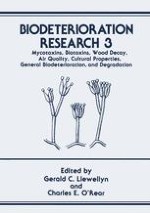1990 | OriginalPaper | Buchkapitel
Aflatoxin M1 Contamination of Milk Samples in Virginia During 1981 to 1987
verfasst von : Richard L. Mooney, Gerald C. Llewellyn
Erschienen in: Biodeterioration Research
Verlag: Springer US
Enthalten in: Professional Book Archive
Aktivieren Sie unsere intelligente Suche, um passende Fachinhalte oder Patente zu finden.
Wählen Sie Textabschnitte aus um mit Künstlicher Intelligenz passenden Patente zu finden. powered by
Markieren Sie Textabschnitte, um KI-gestützt weitere passende Inhalte zu finden. powered by
Aflatoxin B1 (AFB1 ), when fed to dairy cattle, has been shown to yield the milkborne metabolite aflatoxin M1 (AFM1)(Figure 1). AFM1 carry over into milk via the secretory route is low (2% ± 1% of AFB1 introduced), but has been shown to be increased by treatment with polyhalogenated biphenyls (Heeschen and Bluethgen, 1989). Higher levels of AFB1 grain contamination in feed thus yields higher levels of AFM1 in the milk produced (Zimmerli and Blaser, 1979). AFM1 has been shown to be both toxic and carcinogenic (Hsieh et al., 1986). Even though AFM1 is less toxic when compared to its unoxidized precursor, AFB1, the risks that are posed to humans through the consumption of dairy products warrant concern. The toxicity and related carcinogenicity of AFM1 has prompted the testing of milk and associated products for the its presence and is addressed via the U.S. FDA (Federal Regulation) action level of 0.5 ppb AFM1. Methods for quantifying aflatoxin include, thin-layer chromatography (TLC), high pressure liquid chromatography (HPLC), and monoclonal antibody technology. The current Association of Official Analytical Chemists methods for analysis utilizes HPLC to quantify aflatoxins (Williams, 1984).
